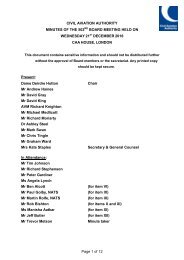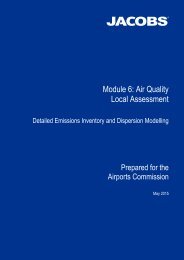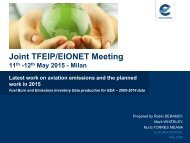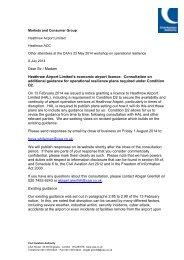NATS-Annual-Report-2015
NATS-Annual-Report-2015
NATS-Annual-Report-2015
Create successful ePaper yourself
Turn your PDF publications into a flip-book with our unique Google optimized e-Paper software.
<strong>Annual</strong> <strong>Report</strong> and Accounts <strong>2015</strong> | <strong>NATS</strong> Holdings Limited<br />
Governance 59<br />
<strong>Report</strong>s from Board Committees<br />
(continued)<br />
of value in use, including the extent to which business plan<br />
cash flow projections are achievable taking account of<br />
the outcome of regulatory reference period reviews; and<br />
assessing net realisable values, including the extent of any<br />
premium to regulatory asset values.<br />
The Committee addressed these matters by considering:<br />
NERL’s revenue allowances and the cash flows implied by<br />
the Reference Period 2 (RP2) settlement, for determining<br />
value in use; the cost of capital assumption used to discount<br />
value in use; the value of NERL’s regulatory assets, including<br />
the scope for out-performance of regulatory settlements<br />
as well as premia to regulatory assets implied by market<br />
transactions in regulated entities, for determining net<br />
realisable value; the outcome of internal asset impairment<br />
reviews; and appropriate sensitivities. Further information is<br />
provided in notes 13, 14 and 15.<br />
Retirement benefits<br />
The pension funding position determined under<br />
international accounting standards requires a number of<br />
actuarial assumptions to be made, including judgements<br />
in relation to long term interest rates, inflation, longevity,<br />
salary growth and investment returns.<br />
The Audit Committee reviews the basis for determining<br />
these assumptions annually and takes account of the<br />
Trustees’ latest valuation and assumptions. The final<br />
calculations in respect of the defined benefit pension<br />
scheme are performed by a qualified actuary, independent<br />
of the scheme. Note 28 sets out the main actuarial<br />
assumptions used, including sensitivity analysis.<br />
Revenue recognition and the recoverability<br />
of revenue allowances<br />
The economic regulatory price control for UK en route<br />
services allows for the recovery (or reimbursement) of<br />
revenue allowances where actual traffic volumes or inflation<br />
are different to the regulator’s forecasts made at the start<br />
of the reference period, where actual service performance<br />
is different to the regulator’s annual targets and for<br />
adjustments brought forward from the previous charge<br />
control period. <strong>NATS</strong>’ policy is to recognise these revenue<br />
adjustments in the year of service, based on traffic, inflation<br />
and service performance experienced.<br />
The Committee considered the relevant EC Charging<br />
Regulations and the conditions of NERL’s air traffic services<br />
licence for RP2 in determining whether these revenue<br />
adjustments are recoverable. The recoverable revenue<br />
allowances are reported in note 16.<br />
b. Internal control<br />
The Board is responsible for the group’s system of internal<br />
control and for reviewing its effectiveness.<br />
<strong>NATS</strong>’ system of internal control is designed to ensure<br />
that the significant financial, operational, safety, legal,<br />
compliance and business risks faced by the group are<br />
identified, evaluated and managed to acceptable levels.<br />
This system was in place during the year and up to the<br />
date of approval of the <strong>Annual</strong> <strong>Report</strong> and Accounts.<br />
However, as with all such systems, internal controls can<br />
provide reasonable but not absolute assurance against<br />
misstatement or loss.<br />
The Audit Committee’s work in the area of internal control<br />
included reviewing reports by the internal and external<br />
auditors, reviewing reports of any attempted or actual<br />
frauds, and consideration of the circumstances of<br />
whistleblowing reports.<br />
c. Risk management<br />
Risk management is essential in seeking to minimise the<br />
threat that an event or action might have on the group’s<br />
ability to achieve its objectives and to execute its strategies<br />
effectively. Successful risk management ensures that<br />
the group is able to consistently deliver services to its<br />
customers and meet the needs and expectations of its<br />
shareholders in a fast changing and uncertain environment.<br />
The Board takes the management of risk very seriously,<br />
paying particular attention to areas such as safety, service<br />
delivery, operating efficiency, financial control, project<br />
delivery, regulatory compliance, financing and IT systems.<br />
Governance






